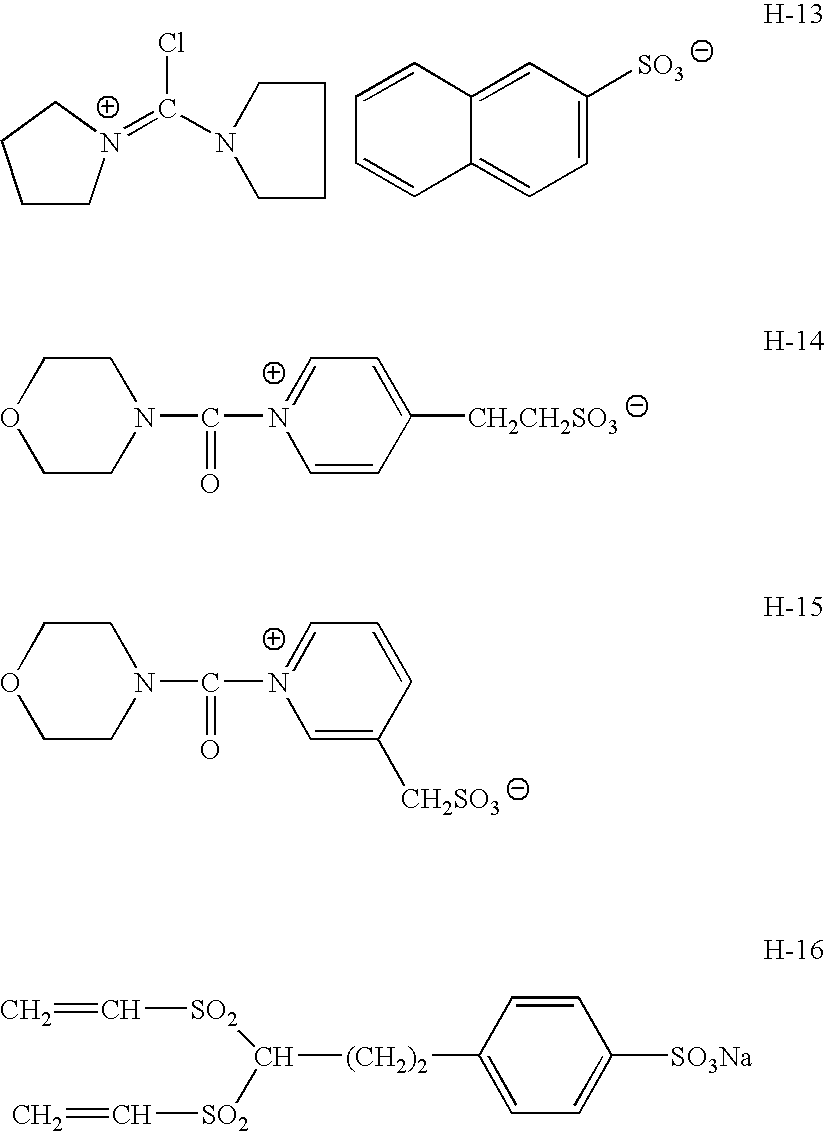Photosensitive material, method of manufacturing conductive metal film, conductive metal film and light-transmitting film shielding electromagnetic wave for plasma display panel
a technology of shielding electromagnetic wave and photosensitive materials, which is applied in the direction of photosensitive materials, metallic image processing, instruments, etc., can solve the problems of health problems of operators of facilities, difficulty in recognizing characters displayed on the screen, and screen darkening, so as to reduce the resistance value
- Summary
- Abstract
- Description
- Claims
- Application Information
AI Technical Summary
Benefits of technology
Problems solved by technology
Method used
Image
Examples
example 1
Preparation of Emulsion A
[0220]First Solution:
[0221]
Water750mlGelatin20gSodium chloride1.6g1,3-dimethylimidazolidine-2-thion20mgSodium benzene thiosulfonate10mgCitric acid0.7mg[0222]Second Solution:
[0223]
Water300 mlSilver nitrate150 g[0224]Third Solution:
[0225]
Water300mlSodium chloride38gPotassium bromide32gPotassium hexachloroiridate (III)5ml(0.005% KCl 20% aqueous solution)Ammonium hexachlororhodate7ml(0.001% NaCl 20% aqueous solution)
[0226]A potassium hexachloroiridate (III) (0.005% KCl 20% aqueous solution) and an ammonium hexachlororhodate (0.001% NaCl 20% aqueous solution) that are used in the third solution were prepared by dissolving powders thereof, respectively, in a 20% KCl aqueous solution and a 20% NaCl aqueous solution, followed by heating at 40° C. for 120 min.
[0227]To the first solution kept at 38° C. and pH 4.5, amounts equivalent to 90% of the respective second and third solutions were simultaneously added under stirring over 20 min, and thereby nuclei of 0.15 μm w...
example 2
Preparation of Samples 2-1 to 2-4
[0292]Except that, in the sample 1-1 according to the example 1, to the emulsion layer, 90 mg / m2 of 2,4-dichloro-6-hydroxy-1,3,5-triazine sodium salt was added, and, to the gelatin, 15% by weight of colloidal silica having a particle diameter of 10 μm, 100 mg / m2 of aqueous latex (aqL-6), 150 mg / m2 of polyethyl acrylate latex, 150 mg / m2 of a latex copolymer of methyl acrylate, 2-acrylamide-2-methyl propane sulfonate sodium salt and 2-acetoxyethyl methacrylate (weight ratio 88:5:7) and 150 mg / m2 of core-shell type latex (core: styrene / butadiene copolymer (weight ratio 37 / 63), shell: styrene / 2-acetoxyethyl acrylate (weight ratio 84 / 16), and core / shell ratio=50 / 50) were added, utterly similarly to the sample 1-1, a sample 2-1 was obtained.
[0293]In the sample 2-1, only an amount of coated silver, an amount of coated gelatin and an amount of coated (Cpd-7) were altered as shown in Table 2 and thereby samples 2-2 to 2-4 were obtained. Here, when the weight ...
example 3
[0297]Except that, in the samples 1-1 to 1-4 prepared in the example 1, a spectral sensitizing dye SD-1 was altered to a spectral sensitizing dye SD-2, the Cpd-14 was altered to Cpd-YF below, and a back layer was not coated, similarly to the samples 1-1 to 1-4, samples 3-1 to 3-4 were prepared. Furthermore, except that in the samples 2-1 to 2-4 prepared in the example 2, the spectral sensitizing dye SD-1 was altered to the spectral sensitizing dye SD-2, the Cpd-14 was altered to Cpd-YF below, and a back layer was not coated, similarly to the samples 2-1 to 2-4, samples 3-5 to 3-8 were prepared. Coating amounts of the SD-2 and Cpd-YF were set to amounts (mole m2) same as that of SD-1 and Cpd-14.
[0298]The obtained samples were subjected to exposure by use of a contact printer with a high-pressure mercury lamp as a light source through a mesh-like photomask having a fine line width of 10 μm and a grid separation of 300 μm, followed by applying a development process and a plating proces...
PUM
| Property | Measurement | Unit |
|---|---|---|
| weight ratio | aaaaa | aaaaa |
| weight ratio | aaaaa | aaaaa |
| transparency | aaaaa | aaaaa |
Abstract
Description
Claims
Application Information
 Login to View More
Login to View More - R&D
- Intellectual Property
- Life Sciences
- Materials
- Tech Scout
- Unparalleled Data Quality
- Higher Quality Content
- 60% Fewer Hallucinations
Browse by: Latest US Patents, China's latest patents, Technical Efficacy Thesaurus, Application Domain, Technology Topic, Popular Technical Reports.
© 2025 PatSnap. All rights reserved.Legal|Privacy policy|Modern Slavery Act Transparency Statement|Sitemap|About US| Contact US: help@patsnap.com



